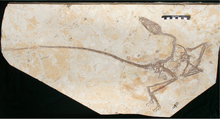Wulong bohaiensis
| Wulong bohaiensis | |
|---|---|

| |
| Skeleton of the holotype | |
| Scientific classification | |
| Domain: | Eukaryota |
| Kingdom: | Animalia |
| Phylum: | Chordata |
| Clade: | Dinosauria |
| Clade: | Saurischia |
| Clade: | Theropoda |
| Family: | †Dromaeosauridae |
| Clade: | †Microraptoria |
| Genus: | †Wulong Poust et al., 2020 |
| Species: | †W. bohaiensis
|
| Binomial name | |
| †Wulong bohaiensis Poust et al., 2020
| |
Wulong (meaning "dancing dragon") is a genus of microraptorine dromaeosaurid dinosaurs from the Early Cretaceous (Aptian) Jiufotang Formation of China. The genus includes a single species, Wulong bohaiensis. The skeletal remains, which include preserved feathers, represent a juvenile.[1][2][3]
Discovery

The Wulong
In 2020, Poust alongside his former advisor David Varricchio from
Description
The proportionally long tail of Wulong is about twice as long as its body. The skeleton has hollow bones. The remains belong to a juvenile individual, about one-year-old.[1][5]
The long, narrow skull of Wulong is large in relation to the body. It is 1.15 times the length of the
Feathers and colouration
The specimen displays soft tissue preservation, including feathered wings on its arms and legs, and two long plumes at the end of the tail, similar to the extinct Microraptor and Confuciusornis and the extant quetzal. However unlike the related Microraptor, there is no evidence that Wulong had a fan of feathers at the end of the tail. The long pair tail feathers present in an immature individual suggests that they were likely not used for mating, and possibly not other ornamental purposes.[1]
In 2023, Croudace and colleagues described the likely
Classification
Poust et al. (2020) recovered Wulong as a
Microraptorinae
|
|
See also
References
- ^ PMID 31943887.
- ^ Hodge, Rae (17 January 2020). "Pocket-size raptor sheds new light on the links between dino and bird life - This "dancing dragon," a new species of feathered dinosaur, was discovered in one of the richest fossil deposits in the world". CNET. Retrieved 19 January 2020.
- ^ Rayne, Elizabeth (18 January 2020). "This New Dinosaur Just Called It: Even Feathered Dinos Were Nothing Like Birds". SyfyWire. Retrieved 19 January 2020.
- ^ Poust, Ashley W. (2014). Description and ontogenetic assessment of a new Jehol microraptorine (PDF) (MSc). Montana State University.
- ^ .
